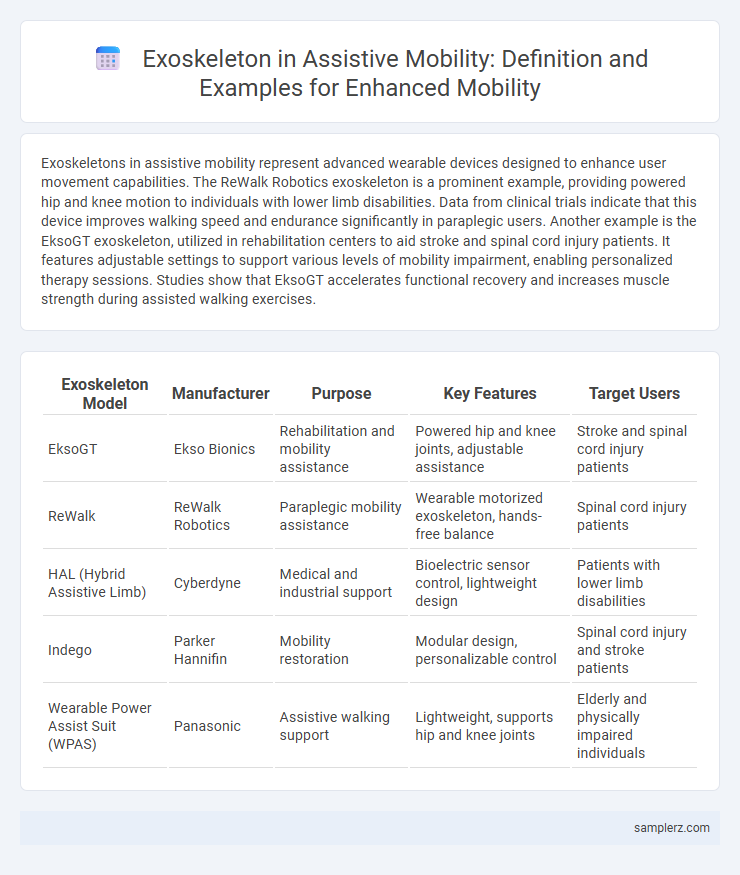Exoskeletons in assistive mobility represent advanced wearable devices designed to enhance user movement capabilities. The ReWalk Robotics exoskeleton is a prominent example, providing powered hip and knee motion to individuals with lower limb disabilities. Data from clinical trials indicate that this device improves walking speed and endurance significantly in paraplegic users. Another example is the EksoGT exoskeleton, utilized in rehabilitation centers to aid stroke and spinal cord injury patients. It features adjustable settings to support various levels of mobility impairment, enabling personalized therapy sessions. Studies show that EksoGT accelerates functional recovery and increases muscle strength during assisted walking exercises.
Table of Comparison
| Exoskeleton Model | Manufacturer | Purpose | Key Features | Target Users |
|---|---|---|---|---|
| EksoGT | Ekso Bionics | Rehabilitation and mobility assistance | Powered hip and knee joints, adjustable assistance | Stroke and spinal cord injury patients |
| ReWalk | ReWalk Robotics | Paraplegic mobility assistance | Wearable motorized exoskeleton, hands-free balance | Spinal cord injury patients |
| HAL (Hybrid Assistive Limb) | Cyberdyne | Medical and industrial support | Bioelectric sensor control, lightweight design | Patients with lower limb disabilities |
| Indego | Parker Hannifin | Mobility restoration | Modular design, personalizable control | Spinal cord injury and stroke patients |
| Wearable Power Assist Suit (WPAS) | Panasonic | Assistive walking support | Lightweight, supports hip and knee joints | Elderly and physically impaired individuals |
Introduction to Exoskeletons in Assistive Mobility
Exoskeletons in assistive mobility are wearable robotic devices designed to enhance or restore movement for individuals with mobility impairments. These systems integrate sensors, actuators, and control algorithms to support walking, standing, and other motor functions. Popular examples include the ReWalk and EksoGT exoskeletons, which facilitate rehabilitation and improve quality of life for stroke survivors and spinal cord injury patients.
Key Benefits of Exoskeletons for Mobility Assistance
Exoskeletons enhance mobility assistance by providing powered support that improves walking speed, stability, and endurance for individuals with mobility impairments. Advanced sensors and actuators in devices like ReWalk and Ekso Bionics enable adaptive movement, reducing fatigue and promoting independence. Clinical studies show that exoskeleton use leads to improved muscle strength, decreased risk of secondary health complications, and enhanced quality of life for users with spinal cord injuries or stroke.
Lower Limb Exoskeletons: Enhancing Walking Capabilities
Lower limb exoskeletons significantly improve walking capabilities for individuals with mobility impairments by providing powered support to hip, knee, and ankle joints. These wearable robotic systems enable users to achieve greater stability, endurance, and gait normalization during ambulation. Advanced models incorporate sensors and motors that adapt to real-time biomechanics, promoting natural movement patterns and reducing fatigue.
Upper Limb Exoskeletons for Daily Living Aid
Upper limb exoskeletons for daily living aid enhance arm and hand mobility, enabling individuals with motor impairments to perform tasks such as eating, dressing, and writing independently. These wearable robotic devices integrate sensors and actuators to support natural movement, reduce muscle fatigue, and improve fine motor skills. Clinical studies demonstrate significant improvements in user autonomy and quality of life, highlighting their impact in assistive mobility technology.
Pediatric Exoskeletons: Mobility for Children with Disabilities
Pediatric exoskeletons are specialized wearable robots designed to support children with mobility impairments, enhancing their ability to walk and engage in physical activities. These devices use sensors and motorized joints to aid in gait training, improve muscle strength, and promote neuroplasticity in developing children with conditions like cerebral palsy or spinal cord injuries. Clinical studies show that consistent use of pediatric exoskeletons can significantly improve children's independence, balance, and overall quality of life.
Robotic Exoskeletons for Spinal Cord Injury Patients
Robotic exoskeletons provide critical support for spinal cord injury patients by enabling improved mobility and rehabilitation outcomes through powered joint movements and real-time feedback systems. These assistive devices integrate advanced sensors and AI algorithms to facilitate personalized gait training, enhancing muscle strength and reducing secondary complications. Clinical studies demonstrate that robotic exoskeleton use promotes neuroplasticity and improves cardiovascular health in individuals with paraplegia.
Exoskeletons in Stroke Rehabilitation and Recovery
Exoskeletons in stroke rehabilitation enhance mobility by providing targeted support and facilitating repetitive, controlled movements to improve motor function and reduce muscle atrophy. Devices like the EksoGT and ReWalk offer customizable gait training, promoting neuroplasticity and accelerating recovery in patients with hemiparesis. Clinical studies demonstrate significant improvements in walking speed, balance, and muscle strength, underscoring the efficacy of exoskeleton-assisted therapy in post-stroke mobility restoration.
Exoskeleton Innovations for Elderly Mobility Support
Exoskeleton innovations for elderly mobility support include lightweight, sensor-driven wearable devices that enhance gait stability and reduce fall risk by providing real-time feedback and adaptive assistance. Advanced robotic exoskeletons incorporate AI algorithms to customize movement patterns, improving muscle strength and endurance in seniors with mobility impairments. These technologies facilitate independent walking, rehabilitation, and daily activity performance, significantly improving quality of life for older adults.
Real-World Case Studies: Exoskeletons Changing Lives
Exoskeletons like the ReWalk and EksoGT have transformed mobility for individuals with spinal cord injuries, enabling them to stand, walk, and perform daily activities independently. Case studies demonstrate significant improvements in muscle strength, cardiovascular health, and psychological well-being after consistent use of these devices in rehabilitation settings. Real-world applications highlight how powered exoskeletons facilitate increased mobility, reduce secondary complications, and enhance the quality of life for people with mobility impairments.
Future Trends in Assistive Exoskeleton Mobility
Emerging trends in assistive exoskeleton mobility emphasize integration of AI-driven adaptive control systems that enhance user-specific movement patterns and reduce fatigue. Lightweight, energy-efficient materials coupled with advanced sensor networks enable real-time biomechanical feedback, improving stability and balance for individuals with mobility impairments. Collaborative developments in neural interface technology promise seamless brain-machine interaction, facilitating intuitive control and expanding the scope of personalized rehabilitation.

example of exoskeleton in assistive mobility Infographic
 samplerz.com
samplerz.com